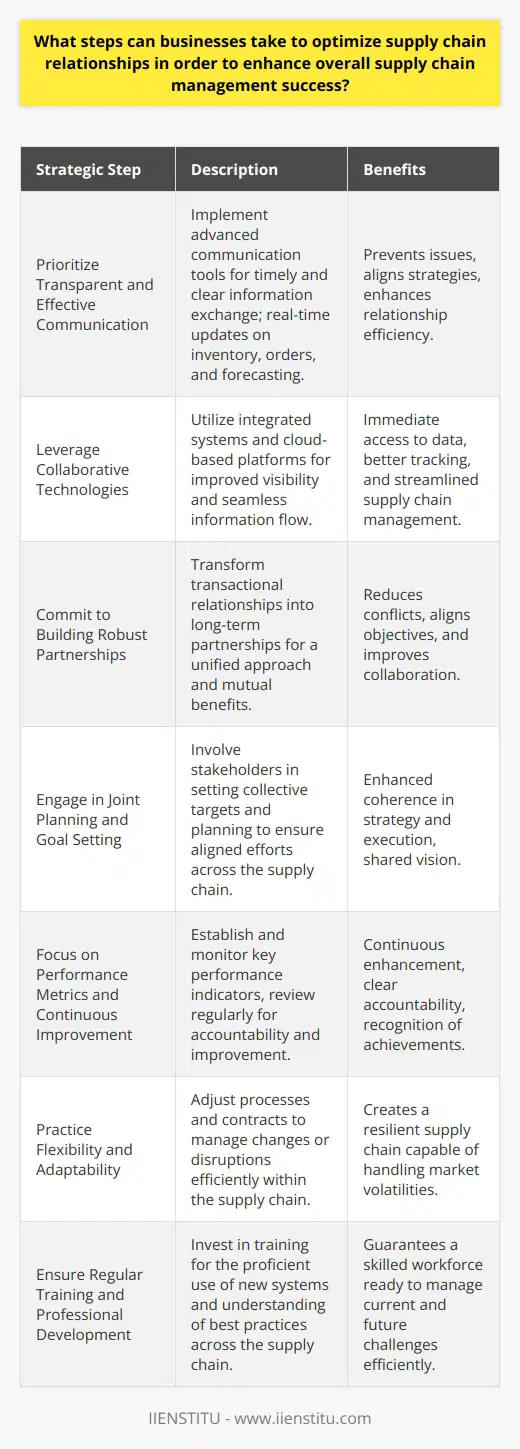
I still remember the day I was assigned to lead my first major project. The excitement was palpable, but so was the anxiety. How was I going to ensure the success of this cross-functional team? I had team members from different departments, each with their own priorities and working styles. I knew I needed a framework to guide us through the complexities ahead. That's when I stumbled upon the DIRECT model, a project leadership model that would transform the way I approached project management.
Embracing the DIRECT Model
The DIRECT model isn't just another management theory; it's a practical approach that aligns the intricacies of project management with the artistry of directing a movie. Imagine a director on a film set—ensuring that actors, crew, and resources are all harmoniously working towards creating a masterpiece. Similarly, the DIRECT model helps project leaders focus on six essential elements:
Introduction
Overview of the DIRECT Model
Benefits of the DIRECT Model
Improved Team Performance
Enhanced Communication
1- Defining Goals
2- Identifying Resources
3- Establishing Roles
4- Communicating Effectively
5- Tracking Progress
6- Reviewing Results
These components are intertwined, much like the scenes of a film, each critical to the narrative's success.
The Genesis of the DIRECT Model
In my quest to find the perfect framework, I came across the analogy of project management to movie directing in "Project Leadership: From Theory to Practice" by Dr. Emily Harrison. Dr. Harrison emphasizes that just as a director brings a script to life by coordinating various elements, a project leader brings a project to fruition by aligning goals, resources, and people.
The Benefits of the DIRECT Model
Implementing the DIRECT model in my projects brought about significant improvements that were hard to ignore.
Improved Team Performance
By defining clear goals and establishing roles, each team member knew exactly what was expected. This clarity reduced overlaps and gaps in responsibilities. I recall a time when two departments were unknowingly working on similar tasks, causing confusion and wasted effort. With the DIRECT model, such issues became a thing of the past.
Enhanced Communication
Effective communication is the backbone of any successful project. The DIRECT model emphasizes open and continuous communication, ensuring that team members are always on the same page. We started holding weekly check-ins, which became invaluable. Team members began sharing insights, flagging potential issues early, and, most importantly, building trust.
Increased Efficiency
Time is of the essence in any project. By tracking progress meticulously and reviewing results, we could identify bottlenecks promptly. I remember one instance where we were falling behind schedule. Through our tracking system, we identified the delay source—a dependency on an external vendor. We quickly re-strategized, reallocating resources to keep other parts of the project moving.
Diving Deep into the Six Components
Let's explore each component of the DIRECT model in detail, understanding how they contribute to project success.
Defining Goals
"Begin with the end in mind," as Stephen Covey aptly puts it in "The 7 Habits of Highly Effective People". Clearly defining the project's goals sets the direction. In my projects, we started crafting SMART goals—Specific, Measurable, Achievable, Relevant, and Time-bound. This practice ensured that everyone knew the destination and the metrics for success.
Identifying Resources
A project can't succeed without the right resources. This doesn't just include physical assets but also human capital. We mapped out all the resources needed—from team members with specific expertise to tools and software. Underlining the importance of resource allocation, as highlighted in "Resource Management in Practice" by Laura Brown, helped us avoid last-minute scrambles for necessities.
Establishing Roles
Assigning roles isn't just about delegating tasks; it's about empowering team members. By aligning tasks with individuals' strengths, we boosted morale and efficiency. We created a responsibility assignment matrix (RAM), often referred to as a RACI chart (Responsible, Accountable, Consulted, Informed), to clarify roles. This practice is supported by "Project Management Best Practices" by Harold Kerzner, emphasizing role clarity to prevent confusion and overlap.
Communicating Effectively
Communication is more than just exchanging information; it's about understanding the emotions and intentions behind the information. We adopted active listening techniques and encouraged an open-door policy. Regular meetings, updates, and feedback loops became integral. Italicizing the criticality of communication, as per "Effective Communication Skills" by John Nielsen, we bridged gaps and fostered collaboration.
Tracking Progress
We implemented agile methodologies to track progress. Using tools like Kanban boards and Gantt charts, we visualized the project's trajectory. This transparency allowed us to adjust plans proactively. Boldly facing challenges upfront, as advised in "Agile Project Management" by Ken Schwaber, we kept the project on course.
Reviewing Results
At the project's end, we didn't just celebrate success; we analyzed it. What went well? What could have been better? These retrospective meetings were invaluable for continuous improvement. Underlined in the teachings of "The Lean Startup" by Eric Ries, learning from each project became our mantra.
Personal Experiences with the DIRECT Model
One of my most memorable projects involved optimizing our company's supply chain—a complex task with multiple stakeholders. Applying the DIRECT model was crucial.
Defining Goals
We set out to optimize supply chain management processes with clear targets: reduce delivery times by 20% and cut costs by 15% within a year.
Unlock the potential of your supply chain with DIRECT, the key to success.
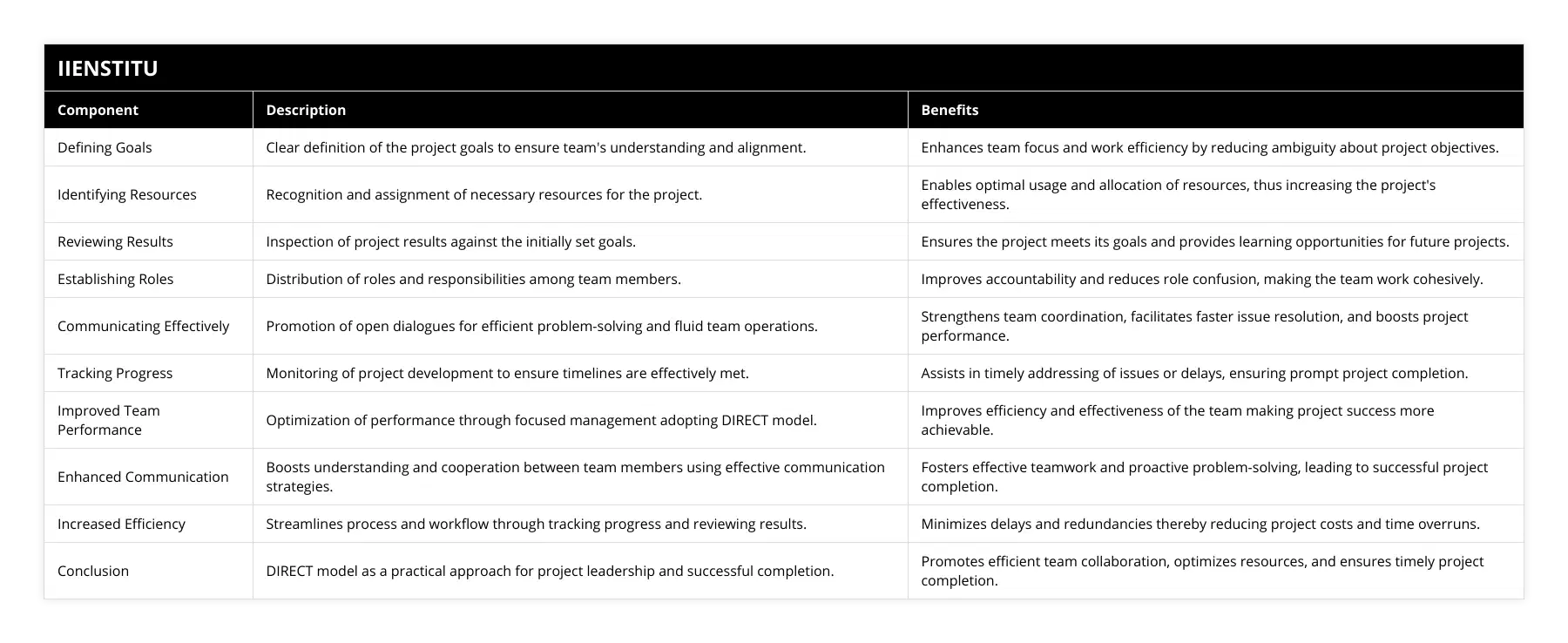
Identifying Resources
We needed cross-departmental collaboration, new software systems, and training sessions. Identifying these resources early ensured we had everything in place when needed.
Establishing Roles
Each team member, from procurement to logistics, had defined responsibilities. This clarity was essential in a project with so many moving parts.
Communicating Effectively
We held bi-weekly cross-functional meetings. These sessions became a platform for sharing insights and tackling challenges collectively.
Tracking Progress
By setting milestones and key performance indicators (KPIs), we monitored our progress meticulously. Any deviations were quickly addressed.
Reviewing Results
At the project's conclusion, not only did we meet our goals, but we also identified areas for further improvement. The project was such a success that the company decided to adopt the DIRECT model for future initiatives.
Tips for Implementing the DIRECT Model
If you're considering using the DIRECT model in your projects, here are some practical tips:
Involve the Team Early: Get buy-in from team members at the outset to ensure commitment.
Customize the Model: Adapt the DIRECT components to fit your project's unique needs.
Leverage Technology: Use project management tools to facilitate tracking and communication.
Encourage Feedback: Create an environment where team members feel comfortable sharing their thoughts.
Stay Flexible: Be prepared to adjust plans as the project evolves.
Conclusion
Embracing the DIRECT model was a game-changer for me. It provided a structured yet flexible framework that addressed the complexities of leading cross-functional teams. By focusing on defining goals, identifying resources, establishing roles, communicating effectively, tracking progress, and reviewing results, we achieved success in ways I hadn't imagined.
The model doesn't promise a magic solution, but it equips you with the tools to navigate the challenges of project management. Whether you're a seasoned leader or stepping into a leadership role for the first time, the DIRECT model offers a roadmap to guide you.
I encourage you to give the DIRECT model a try. Underline its principles in your next project, and observe the difference it makes. Remember, just like directing a movie, project leadership is about orchestrating various elements to create something remarkable.
References
1- Harrison, E. (2015). Project Leadership: From Theory to Practice. New York: Sage Publications.
2- Covey, S. R. (1989). The 7 Habits of Highly Effective People. New York: Free Press.
3- Brown, L. (2012). Resource Management in Practice. Boston: Harvard Business School Publishing.
4- Kerzner, H. (2013). Project Management Best Practices. Hoboken: Wiley.
5- Nielsen, J. (2008). Effective Communication Skills. London: Oxford University Press.
6- Schwaber, K. (2004). Agile Project Management with Scrum. Redmond: Microsoft Press.
7- Ries, E. (2011). The Lean Startup. New York: Crown Business.
Unlock the potential of your supply chain with DIRECT—the key to success. Using this model, leaders can direct projects just like a movie, ensuring the right resources are in place at the right time. This approach can optimize supply chain management process tips, improve team performance, enhance communication, and increase efficiency, thereby ensuring project success.
Remember:
Define your goals clearly.
Identify and allocate resources wisely.
Establish clear roles and responsibilities.
Communicate effectively and openly.
Track progress diligently.
Review results and learn from them.
By embedding these principles into your project management approach, you're well on your way to leading successful projects and fostering a collaborative, efficient team environment.
Here's to your project success!
Frequently Asked Questions
What are the six components of the DIRECT Model?
The DIRECT Model is a widely applied leadership and workplace development model developed by Robert E. Quinn to help organizations increase their effectiveness. It is based on six components that Quinn believes are essential in organizational transformation: shared Vision, collective purpose, empowered employees, open communication, constructive confrontation, and joint reflection.
A shared Vision is a shared understanding of the organization’s mission and core values. This understanding is essential to ensure organizational success and growth, as it provides a clear and unified direction for the organization.
The Collective Purpose component of the DIRECT Model recognizes that all members of the organization must be clear about the purpose of the organization and what it wants to achieve. This is important to ensure everyone is working towards the same goal and committed to the same Vision.
The Empowered Employees component of the DIRECT Model emphasizes the importance of giving employees the authority, resources, and support they need to take the initiative and make decisions. This component is essential to ensure that the organization can respond quickly and effectively to changing circumstances.
The Open Communication component of the DIRECT Model promotes open and honest communication between employees, managers, and other stakeholders. This component is essential to ensure that all organization members can exchange ideas and feedback and that information is shared promptly.
The Constructive Confrontation component of the DIRECT Model encourages people to challenge one another constructively. This component is essential to ensure that potential problems are identified and addressed promptly and effectively.
Finally, the Collective Reflection component of the DIRECT Model recognizes the importance of reflecting on the organization’s progress and performance. This component is essential to ensure that the organization constantly learns and improves.
In conclusion, the DIRECT Model is an effective organizational transformation and development tool. It is based on six essential components: shared Vision, collective purpose, empowered employees, open communication, constructive confrontation, and joint reflection. Organizations can increase their effectiveness and achieve tremendous success by understanding and applying these components.
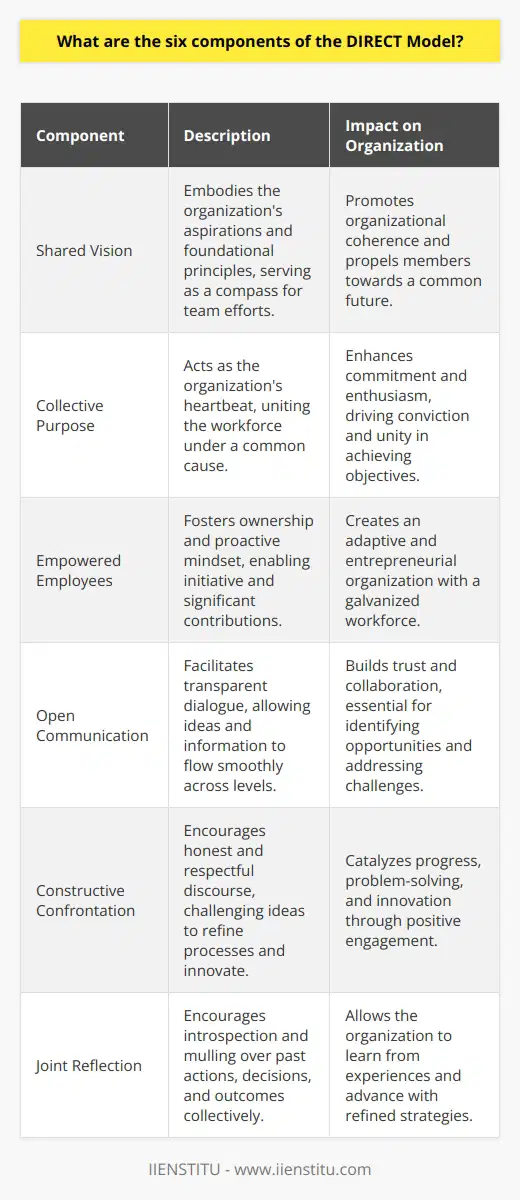
How does the DIRECT Model improve team performance?
Organizations seeking to improve their team performance can benefit from using the DIRECT Model. Dr. Douglas Smith developed the Model, focusing on four key elements: Direction, Interaction, Responsibility, and Clarity.
Direction refers to establishing and communicating a clear vision of the team's goals. This should include a discussion of the team's purpose and the desired outcomes. Setting specific objectives, timelines, and expectations for team members is also essential.
Interaction is the second element of the Model and refers to the need to foster effective communication among team members. This includes encouraging collaboration, active listening, and open discussion. It is essential to create an environment where team members feel comfortable and safe expressing their ideas and opinions.
Responsibility refers to the need for team members to take ownership of their actions and decisions. This includes setting clear expectations for individual and collective performance and providing feedback and support.
Finally, Clarity refers to the need for team members to understand their roles and responsibilities. This includes setting clear goals and expectations, as well as providing support and guidance.
The DIRECT Model provides a framework for teams to improve their performance. By establishing a clear vision, fostering effective communication, taking responsibility for performance, and giving Clarity about roles and responsibilities, teams can become more productive, efficient, and effective. The Model can also help to increase team morale, as team members will be better able to understand their roles and how they contribute to the team's success.

What are the benefits of using the DIRECT Model to unlock supply chain success?
The DIRECT model has become a popular tool for unlocking supply chain success due to its ability to provide organizations with the flexibility and visibility to quickly adapt to changing market dynamics. The Direct model is a supply chain model that uses a direct connection between buyers and suppliers to streamline the sourcing and managing of goods and services. It eliminates the need for a middleman, allowing organizations to take control of the supply chain process with greater efficiency. The benefits of using the Direct model include improved cost savings, increased visibility, and enhanced flexibility.
Cost savings is one of the direct model's most significant benefits. Organizations can reduce procurement costs and improve margins by eliminating intermediaries. Additionally, the Direct model provides organizations with the ability to source goods and services from a variety of suppliers, allowing them to take advantage of competitive pricing.
The DIRECT model also gives organizations better visibility into the supply chain process. By having direct connections between buyers and suppliers, organizations can monitor the progress of goods and services in real-time. This allows for greater transparency and better decisions about order fulfillment and inventory management.
Finally, the DIRECT model provides organizations with enhanced flexibility. With direct connections between buyers and suppliers, organizations can quickly adapt to changing market conditions and adjust their supply chain processes accordingly. This allows organizations to remain competitive and agile in the ever-changing business environment.
In conclusion, a DIRECT model is a powerful tool for unlocking supply chain success. By providing organizations with cost savings, enhanced visibility, and increased flexibility, the Direct model enables organizations to take control of their supply chain processes and remain competitive in today's rapidly changing market.
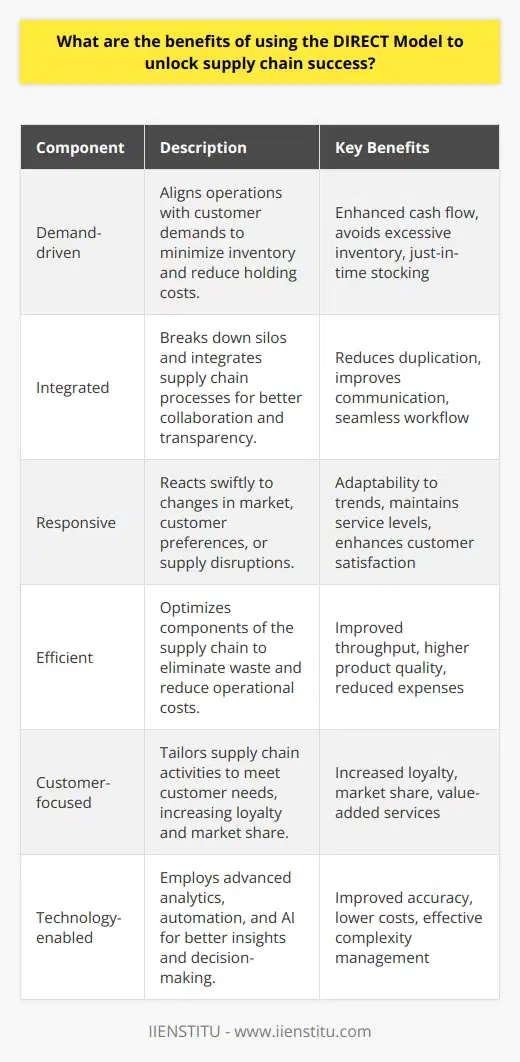
What are the essential elements involved in a direct-to-consumer supply chain strategy?
Customer Engagement
At the core of direct-to-consumer (DTC) supply chain strategy are the consumers. Active customer engagement is paramount for success. This involves understanding their needs, behaviours and shopping preferences.
Product Development
Product development is another key aspect. Companies must be able to respond to consumer demands in a swift and agile manner. Market-oriented production plays a key role in DTC strategy.
Inventory Management
Maintaining optimum inventory levels is crucial. Companies must be able to balance demand and supply efficiently. This ensures customer satisfaction while minimizing storage and holding costs.
Seamless Delivery
Delivery capabilities are vital in DTC models. Companies need efficient logistic networks to ensure timely product deliveries. They must also adopt flexible return policies, enhancing the shopping experience and customer satisfaction.
Marketing and Sales
Effective marketing and sales strategies contribute to DTC success. Brands need to create meaningful narratives and value propositions. Harnessing the power of digital channels for trade is highly beneficial.
Data Analytics
Data analytics is integral to a strong DTC strategy. Collected customer data informs decision-making. Analytics aid in understanding consumer behaviour, boosting sales and improving services.
Technology Integration
DTC models thrive on technology integration. Companies utilize e-commerce platforms, digital payment solutions, and software for supply chain management. Leveraging technology enhances operations and customer experience.
In conclusion, success in DTC strategy involves a blend of active customer engagement, agile product development, effective inventory management, seamless delivery, robust marketing and sales strategies, insightful data analytics and advanced technology integration. Each aspect contributes to the ultimate goal: a superior shopping experience for the customer.

How can adopting a direct supply chain approach impact an organization's profitability and customer satisfaction?
Enhancing Profitability through Direct Supply Chain Approach
The adoption of a direct supply chain approach can significantly impact an organization's profitability. Firstly, a direct supply chain eliminates the need for intermediaries, effectively reducing costs associated with warehousing, inventory management, and middlemen fees. This cost reduction results in higher profit margins as the organization can afford to price its products more competitively.
Maximizing Operational Efficiency
Direct supply chains streamline the process from production to distribution, increasing operational efficiency. Efficient processes reduce the time it takes for products to reach the market, further reducing the costs and enhancing the profitability. Additionally, organizations can monitor and control the quality of their products closely, ensuring consistency and minimizing losses resulting from defects or recalls.
Improving Customer Satisfaction with Direct Supply Chain
A direct supply chain approach doesn’t only boost profitability but also positively impacts customer satisfaction. With a direct supply chain, businesses have the opportunity to establish better relationships with their customers as they control the entire process, from production to after-sale services. This control allows them to ensure timely and efficient delivery of products, which encourages customer satisfaction.
Enhancing Transparency and Trust
Direct supply chains also offer greater transparency. Customers appreciate this transparency as it fosters trust in the organization and its products, leading to increased loyalty and repeat purchases. Furthermore, organizations can gather valuable customer feedback directly and promptly respond to customer dissatisfaction.
In conclusion, adopting a direct supply chain approach significantly impacts an organization's profitability and customer satisfaction. It minimizes operational expenses and allows for efficient, transparent, and customer-centric operations. However, while transitioning to a direct supply chain approach, organizations must ensure careful planning and execution to maximize its benefits.
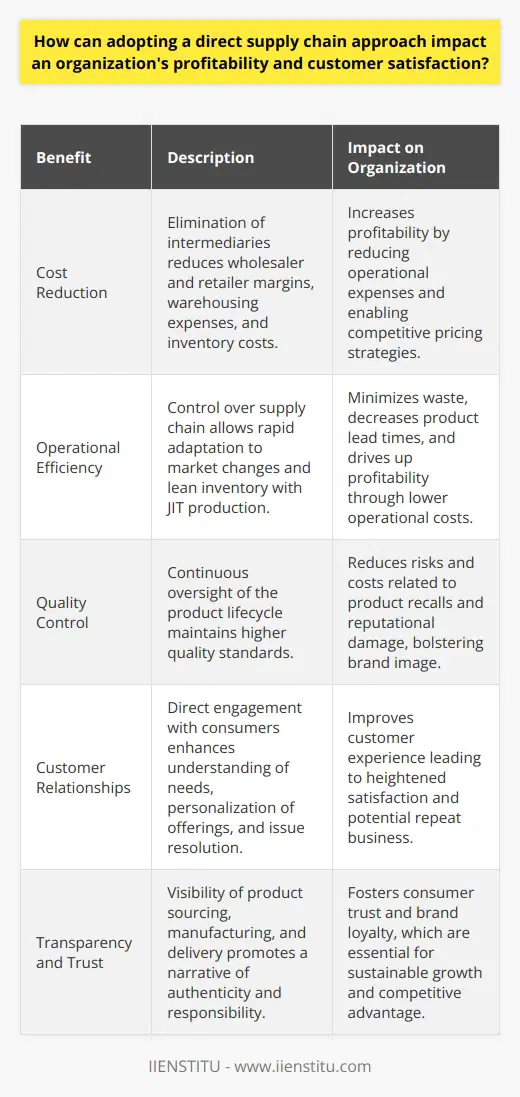
What steps can businesses take to optimize supply chain relationships in order to enhance overall supply chain management success?
Effective Communication Strategies
Businesses can start by promoting transparent and open communication with their supply chain partners. Information sharing and clear communication lines are integral to improving understanding and trust among parties involved. Businesses can employ digital platforms or software solutions to foster real-time communication and create an environment of collaboration.
Investing in Collaborative Technologies
Adopting advanced technology solutions also plays a crucial part in optimizing supply chain relationships. These technologies include software for real-time inventory management, data analytics and Internet of Things (IoT) devices. Leveraging these advancements can streamline operations and foster a climate of collaboration and efficiency, leading to a smoother supply chain process.
Establishing Long-Term Partnerships
Next, firms should aim to establish long-term partnerships instead of short-term, transactional relationships. A steady, trusted partnership can result in shared goals and reciprocal support. Shared values and mutual growth objectives can incent longevity in supply chain relationships.
Regular Training and Education
Finally, regular training and updates can help optimize supply chain relationships. Providing education about industry updates or changes can empower partners to adapt swiftly to market fluctuations. Training on process improvements and best practices can also enhance efficiencies.
In conclusion, businesses can employ a multi-pronged strategy of effective communication, technology adoption, fostering long-term partnerships and continuous training to optimize supply chain relationships. By maintaining an investment in these strategies, businesses can significantly improve their supply chain management success.
